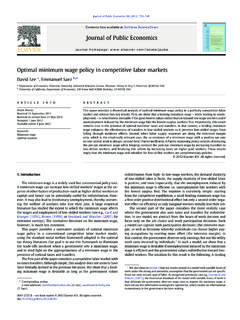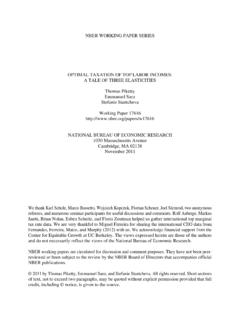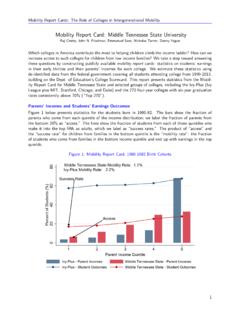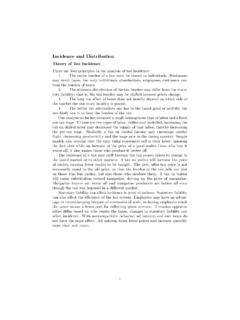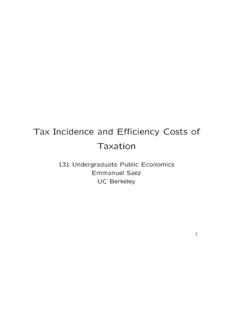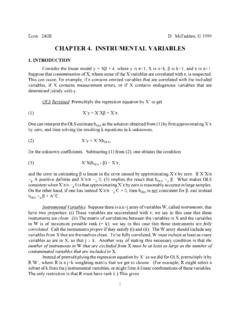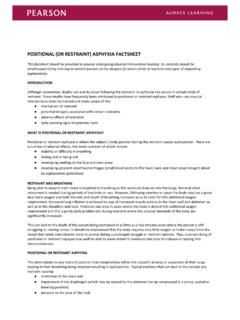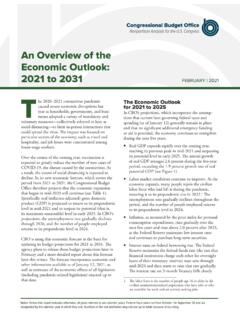Transcription of Money, Interest Rates, and Exchange Rates
1 Slides prepared by Thomas BishopChapter 14 Money, InterestRates, andExchange RatesCopyright 2006 Pearson Addison-Wesley. All rights What is money? Control of the supply of money The demand for money A model of real money balances andinterest Rates A model of real money balances, interestrates and Exchange Rates Long run effects of changes in money onprices, Interest Rates and Exchange ratesCopyright 2006 Pearson Addison-Wesley. All rights Is Money? Money is an asset that is widely used andaccepted as a means of payment. Different groups of assets may be classified asmoney. Currency and checking accounts form a usefuldefinition of money, but the large Interest -bearingbank deposits traded in the foreign exchangemarket are excluded from this 2006 Pearson Addison-Wesley. All rights Is Money? (cont.) Money is very liquid: it can be easily andquickly used to pay for goods and services.
2 Money, however, pays little or no rateof return. Suppose we can group assets into money(liquid assets) and all other assets(illiquid assets). All other assets are less liquid but pay a 2006 Pearson Addison-Wesley. All rights Supply Who controls the quantity of money thatcirculates in an economy, the money supply? Central banks determine the money supply. In the US, the central bank is the FederalReserve System. The Federal Reserve directly regulates the amountof currency in circulation, as well as bankingsystem reserves. It indirectly controls the amount of checkingdeposits issued by private 2006 Pearson Addison-Wesley. All rights Demand Money demand is the proportion of their totalassets that people are willing to hold in theform of money (instead of illiquid assets). We will consider individual money demand andaggregate money demand. What influences willingness to hold money?
3 Copyright 2006 Pearson Addison-Wesley. All rights Influences IndividualDemand for Money? Expected returns/ Interest rate on money relativeto the expected returns on other assets. Risk: the risk of holding money derives principallyfrom unexpected inflation, which might unexpectedlyreduce the purchasing power of money. but domestic-currency bonds have precisely this risk too, sothis risk is not very important in money demand Liquidity: A need for greater liquidity occurs wheneither the price of transactions increases or thequantity of goods normally bought in 2006 Pearson Addison-Wesley. All rights Influences AggregateDemand for Money? Interest Rates : money pays little or no Interest , sothe Interest rate is the opportunity cost of holdingmoney instead of other assets, like bonds, whichhave a higher expected return/ Interest rate. A higher Interest rate means a higher opportunity cost ofholding money lower money demand.
4 Prices: the prices of goods and services bought intransactions will influence the willingness to holdmoney to conduct those transactions. A higher price level means a greater need for liquidity tobuy the same amount of goods and services highermoney 2006 Pearson Addison-Wesley. All rights Influences AggregateDemand for Money? (cont.) Income: greater income implies more goodsand services can be bought, so that moremoney is needed to conduct transactions. A higher real national income (GNP) meansmore goods and services are being producedand bought in transactions, increasing the needfor liquidity higher money 2006 Pearson Addison-Wesley. All rights Model of Aggregate Money DemandThe aggregate demand for money can be expressed by:Md = P x L(R,Y)where:P is the price levelY is real national incomeR is a measure of nominal Interest ratesL(R,Y) is the aggregate real money demandAlternatively:Md/P = L(R,Y)Aggregate real money demand is a function of national incomeand the nominal Interest 2006 Pearson Addison-Wesley.
5 All rights Model ofAggregate Money Demand (cont.)For a given level ofincome, real moneydemand decreasesas the Interest 2006 Pearson Addison-Wesley. All rights Model ofAggregate Money Demand (cont.)When incomeincreases, real moneydemand increases atevery Interest 2006 Pearson Addison-Wesley. All rights Money Market The money market uses the (aggregate) moneydemand and (aggregate) money supply. The condition for equilibrium in the money market is:Ms = Md Alternatively, we can define equilibrium using thesupply of real money and the demand for real money(by dividing both sides by the price level):Ms/P = L(R,Y) This equilibrium condition will yield an equilibriumnominal Interest rate 2006 Pearson Addison-Wesley. All rights Money Market (cont.) When there is an excess supply of Money, there is, correspondingly, an excess demandfor alternative, Interest -bearing assets. People holding excessive money balances arewilling to acquire Interest bearing assets (by buyingthem with money) at a lower Interest rate.
6 Potential money holders are more willing to holdadditional quantities of money as the Interest rate(the opportunity cost of holding money) 2006 Pearson Addison-Wesley. All rights Money Market (cont.) When there is an excess demand formoney, there, correspondingly, is an excesssupply of Interest -bearing assets. People who desire money but do not have accessto it are willing to sell off assets that offer highernominal Interest Rates in return for the moneybalances that they desire. Those with money balances are more willing togive them up in return for Interest bearing assetsas the Interest rate on these assets rises and asthe opportunity cost of holding money (the nominalinterest rate) 2006 Pearson Addison-Wesley. All rights Market EquilibriumCopyright 2006 Pearson Addison-Wesley. All rights in the Money SupplyAn increase inthe money supplylowers the interestrate for a givenprice level andoutputA decrease in themoney supply raisesthe Interest rate for agiven price level 2006 Pearson Addison-Wesley.
7 All rights in National IncomeAn increase innational incomeincreases theequilibrium interestrate for a given 2006 Pearson Addison-Wesley. All rights the Money Market to the ForeignExchange MarketCopyright 2006 Pearson Addison-Wesley. All rights the Money Market to the ForeignExchange Market (cont.)Aggregate realmoney demand,L(R,Y) Interest rate, RReal moneyholdingsAggregate real money supplyMS PR1 Aggregate realmoney demand,L(R,Y) Interest rate, RReal moneyholdingsAggregate real money supplyMS PR1 Linking theMoney Marketto the ForeignExchangeMarket (cont.)Changes inthe DomesticMoney SupplyCopyright 2006 Pearson Addison-Wesley. All rights in the Money Supply An increase in a country s money supplycauses its currency to depreciate. A decrease in a country s money supplycauses its currency to appreciate. (Note: These statements are based on thepolicy experiment in which we hold the futureexpected Exchange rate Ee$/ constant.)
8 Copyright 2006 Pearson Addison-Wesley. All rights in the Foreign Money Supply How would a change in the euro moneysupply affect the US money market andforeign Exchange market (holdingexpectations constant as before)? An increase in the euro zone s money supplycauses a depreciation of the euro (an ap-preciation of the dollar). A decrease in the euro zone s money supplycauses an appreciation of the euro (a de-preciation of the dollar).Copyright 2006 Pearson Addison-Wesley. All rights inthe ForeignMoney Supply(cont.)Copyright 2006 Pearson Addison-Wesley. All rights in theForeign Money Supply (cont.) The increase in the euro zone s money supplyreduces Interest Rates in the euro zone,reducing the expected return on eurodeposits. This reduction in the expected return on eurodeposits leads to a depreciation of the euro. The change in the euro zone s money supplydoes not change the US money 2006 Pearson Addison-Wesley.
9 All rights Run and Short Run In the short run, the money price level is fixed. our analysis heretofore has been a short run analysis. In the long run, money prices of factors of productionand of goods and services are allowed to adjust todemand and supply in their respective markets. Nominal wages adjust to the demand and supply of labor. Real output and income are determined by the supply oflabor and other factors of production by the economy sproductive capacity not by the supply of money. The Interest rate depends on the supply of saving andthe demand for saving in the economy and the expectedinflation rate and thus is also independent of the moneysupply s 2006 Pearson Addison-Wesley. All rights Run and Short Run (cont.) In the long run, the level of the money supplydoes not influence the amount of real output Yor the nominal Interest rate R. But in the long run, the money prices of outputand factors of production adjust proportionallyto changes in the money supply: Long run equilibrium: Ms/P = L(R,Y) Ms = P x L(R,Y) increases in the money supply are matched byproportional increases in the price level.
10 Analogous to effects of currency 2006 Pearson Addison-Wesley. All rights Run and Short Run (cont.) In the long run, there is a direct relationshipbetween the inflation rate (rate of increase inP) and ongoing growth in the money supply: Ms = P x L(R,Y) P = Ms/L(R,Y) P/P = Ms/Ms - L/L The inflation rate equals growth rate in moneysupply minus the growth rate for money 2006 Pearson Addison-Wesley. All rights 2006 Pearson Addison-Wesley. All rights and Prices in the Long Run How does a change in the money supply causeprices of output and inputs to change? Excess demand: an increase in the money supplyimplies that people have more funds available to payfor goods and services. To meet strong demand, producers hire more workers,creating a strong demand for labor, or make existingemployees work harder. Wages rise to attract more workers or to compensateworkers for overtime. Prices of output will eventually rise to compensate forhigher 2006 Pearson Addison-Wesley.
